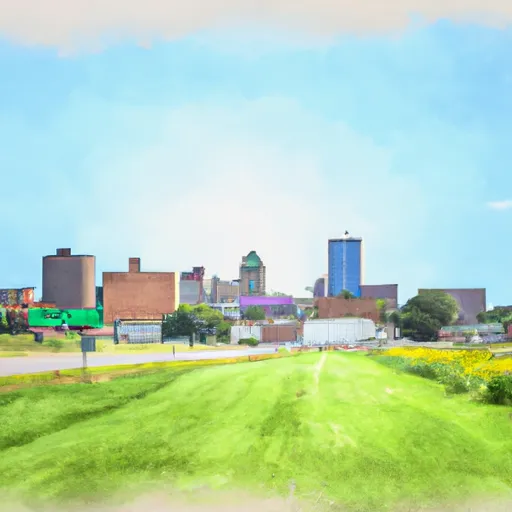-
 Snoflo Premium
Snoflo Premium
Get unlimited access to all our content
With no Ad interruptions! - Start Your Free Trial Login with existing account
Syracuse
Eden Index
Climate
8.1
•
Recreation
0.6
•
Community
4.1
•
Safeguard
4.4/10

Syracuse, Nebraska is a small town located in Otoe County. It has a humid continental climate, characterized by hot summers and cold winters. The average high temperature in the summer months is around 88°F (31°C), while winter temperatures can drop to an average low of 17°F (-8°C). Syracuse experiences moderate precipitation throughout the year, with an annual average of 30 inches (76 cm), including rain and snow.
The town is situated near the Salt Creek, which is a tributary of the Missouri River. This water source contributes to a healthy hydrology system in the area. The hydrology constituents of Syracuse are influenced by the nearby bodies of water, providing ample opportunities for fishing, boating, and water-based activities. The Salt Creek is known for its diverse fish population, including bass, crappie, and catfish.
In terms of outdoor recreation, Syracuse offers several options. The town has a number of parks and recreational areas, providing opportunities for hiking, camping, and picnicking. There are also facilities for sports such as baseball, softball, and basketball. Syracuse Lake, located just south of the town, is a popular spot for boating and water sports. Additionally, the nearby Indian Cave State Park offers extensive trails for hiking, horseback riding, and exploring the scenic bluffs along the Missouri River.
What is the Eden Index?
The Snoflo Eden Index serves as a comprehensive rating system for regions, evaluating their desirability through a holistic assessment of climate health, outdoor recreation opportunities, and natural disaster risk, acknowledging the profound impact of these factors on livability and well-being.
Climate Health Indicator (CHI): 8.1
Syracuse receives approximately
784mm of rain per year,
with humidity levels near 82%
and air temperatures averaging around
11°C.
Syracuse has a plant hardyness factor of
5, meaning
plants and agriculture in this region thrive during a short period during spring and early summer. Most
plants will die off during the colder winter months.
By considering the ideal temperature range, reliable water supplies, clean air, and stable seasonal rain or snowpacks, the Climate Health Indicator (CHI) underscores the significance of a healthy climate as the foundation for quality living.
A healthy climate is paramount for ensuring a high quality of life and livability in a region, fostering both physical well-being and environmental harmony. This can be characterized by ideal temperatures, reliable access to water supplies, clean air, and consistent seasonal rain or snowpacks.
Weather Forecast
Streamflow Conditions
Missouri-Nishnabotna
Area Rivers
Missouri-Nishnabotna
Snowpack Depths
Missouri-Nishnabotna
Reservoir Storage Capacity
Missouri-Nishnabotna
Groundwater Levels
Recreational Opportunity Index (ROI): 0.6
The Recreational Opportunity Index (ROI) recognizes the value of outdoor recreational options, such as parks, hiking trails, camping sites, and fishing spots, while acknowledging that climate plays a pivotal role in ensuring the comfort and consistency of these experiences.
Access to outdoor recreational opportunities, encompassing activities such as parks, hiking, camping, and fishing, is crucial for overall well-being, and the climate plays a pivotal role in enabling and enhancing these experiences, ensuring that individuals can engage in nature-based activities comfortably and consistently.
Camping Areas
| Campground | Campsites | Reservations | Toilets | Showers | Elevation |
|---|---|---|---|---|---|
| Walnut Creek - Papillion | 45 | 1,124 ft | |||
| St Marys Riverside Park | None | 944 ft | |||
| Iron Horse Trail Lake | 11 | 1,132 ft | |||
| Glenn Cunningham Lake | None | 1,130 ft | |||
| Wilson Island State Rec Area | 135 | 1,004 ft | |||
| Centralia Lake | None | 1,285 ft | |||
| Burchard Lake State Wildlife Area | 10 | 1,336 ft | |||
| Louisville Lakes State Rec Area | 300 | 1,032 ft | |||
| Eugene T. Mahoney State Park | 150 | 1,167 ft | |||
| Weeping Water | 25 | 1,081 ft |
Nearby Fishing
Nearby Ski Areas
Catastrophe Safeguard Index (CSI):
The Catastrophe Safeguard Index (CSI) recognizes that natural disaster risk, encompassing floods, fires, hurricanes, and tornadoes, can drastically affect safety and the overall appeal of an area.
The level of natural disaster risk in a region significantly affects safety and the overall livability, with climate change amplifying these risks by potentially increasing the frequency and intensity of events like floods, fires, hurricanes, and tornadoes, thereby posing substantial challenges to community resilience and well-being.
Community Resilience Indicator (CRI): 4.1
The Community Resilience Indicator (CRI) recognizes that education, healthcare, and socioeconomics are crucial to the well-being of a region. The CRI acknowledges the profound impact of these elements on residents' overall quality of life. By evaluating educational resources, healthcare accessibility, and economic inclusivity, the index captures the essential aspects that contribute to a thriving community, fostering resident satisfaction, equity, and social cohesion.

